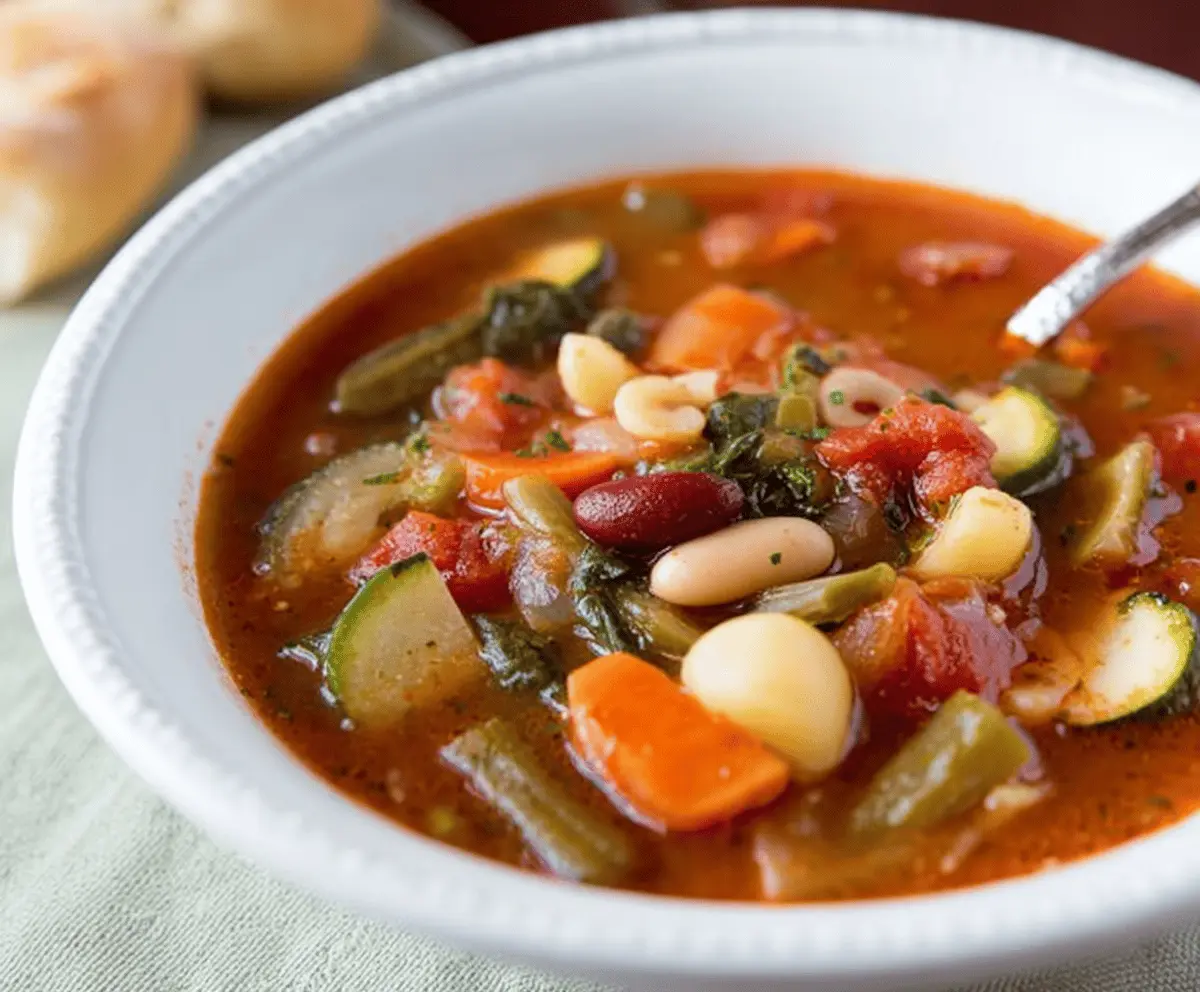Olive Garden Vegetable Soup is a colorful bowl filled with a mix of fresh veggies like zucchini, carrots, tomatoes, and green beans all swimming in a flavorful broth. It’s light but still packed with comforting flavors that make it feel like a warm hug on a chilly day. The herbs and vegetables blend perfectly to create a soup that’s both healthy and satisfying.
I love making this soup when I want something simple but tasty that also makes me feel good about what I’m eating. It’s one of those recipes where the ingredients come together so easily, and you don’t have to worry about complicated steps. Adding a bit of garlic and Italian seasoning always feels like turning the flavor up just right.
My favorite way to enjoy this soup is with a good piece of crusty bread or some parmesan sprinkled on top. It feels like a cozy meal that’s perfect for lunch or dinner any day of the week. Whenever I make it, friends and family always ask for seconds because it’s just that good and fresh-tasting.
Key Ingredients & Substitutions
Vegetables: Carrots, celery, zucchini, potatoes, and green beans add great texture and color. I like using fresh veggies, but frozen works well if you’re in a hurry. Just add them a bit later to avoid overcooking.
Diced Tomatoes: Canned diced tomatoes give the broth a rich, slightly tangy flavor. If you prefer, you can use fresh tomatoes simmered down, but canned is easier and consistent.
Vegetable Broth: A good broth is key since it’s the soup’s base. Low-sodium broth lets you control salt levels better. If unavailable, chicken broth can be substituted for more depth (not vegetarian then).
Small Pasta: Ditalini or elbow macaroni work best. If you don’t have those, tiny shells or orzo are great alternatives. Add pasta at the end so it doesn’t get mushy.
Italian Herbs: Basil, oregano, and parsley bring the classic Italian flavor. Fresh herbs can be used instead, but add them near the end to keep their brightness.
How Can You Keep the Vegetables Tender but Not Mushy?
Cooking the vegetables just right is important for this soup. Here’s how I do it:
- Sauté onions and garlic first to build flavor. This softens them nicely.
- Add sturdy veggies like carrots, celery, potatoes, and green beans early since they take longer to cook.
- Simmer until these veggies are tender but still have a bite (about 15-20 minutes).
- Add zucchini and pasta last since both cook quickly. Simmer only 8-10 minutes more to keep zucchini from getting mushy.
- Keep the pot uncovered during simmering to help the soup develop flavor and keep vegetables firm.
Following these steps keeps the soup fresh and lively with different textures in every spoonful.

Equipment You’ll Need
- Large soup pot – I prefer a big one so everything cooks evenly and you have enough space to stir.
- Wooden spoon or ladle – makes it easy to stir the soup without scratching the pot.
- Chopping board and knife – for prepping all the fresh vegetables quickly and safely.
- Measuring spoons and cups – ensure the herbs and broth are just right.
- Optional: Soup ladle – for serving easily and avoiding spills.
Flavor Variations & Add-Ins
- For extra protein, stir in cooked chicken or beans like chickpeas or cannellini beans. It makes the soup more filling.
- Switch up the herbs by adding fresh basil or thyme near the end for brighter flavor.
- For a little heat, add a pinch of red pepper flakes or diced bell peppers while cooking.
- Try adding a splash of balsamic vinegar or a squeeze of lemon at the end to brighten the overall taste.

Equipment You’ll Need
- Large soup pot or Dutch oven – big enough to hold all the veggies and broth comfortably.
- Wooden spoon or spatula – for stirring the soup as it cooks.
- Knife and cutting board – to chop all the fresh vegetables safely and quickly.
- Measuring cups and spoons – to measure broth, herbs, and other ingredients accurately.
- Soup ladle – helpful for serving your delicious soup into bowls.
Variations and Add-Ins
- Add Protein: Toss in cooked chicken, Italian sausage, or beans like cannellini for a heartier meal.
- Change Up the Pasta: Try orzo, small shells, or even tiny macaroni for a different texture.
- Herb Swaps: Use fresh basil, thyme, or rosemary in place of or alongside the dried herbs for a fresh twist.
- Spice it Up: Add a pinch of red pepper flakes or some chopped jalapeño for extra heat.
- Extra Veggies: Add spinach or kale near the end of cooking for extra green goodness.
- Brighten the Flavor: A splash of lemon juice or a dash of balsamic vinegar right before serving adds lovely brightness.
Can I Use Frozen Vegetables Instead of Fresh?
Yes, frozen vegetables can work great! Just add them a bit later in the cooking process so they don’t become too mushy. Make sure to thaw any large frozen pieces beforehand for even cooking.
How Can I Make This Soup Vegan?
This recipe is already vegan-friendly if you skip the optional Parmesan cheese garnish. Use vegetable broth to keep it plant-based and enjoy the fresh veggie flavors!
Can I Make This Soup Ahead of Time?
Absolutely! The soup tastes even better the next day after the flavors have melded. Store it in an airtight container in the fridge for up to 3 days and reheat gently on the stove.
How Should I Store Leftovers?
Keep leftovers in a sealed container in the fridge for up to 3 days. To reheat, warm the soup on the stove over medium heat, stirring occasionally. If the soup thickens, add a splash of broth or water to loosen it up.